Goldfish
Conservation status: Secure |
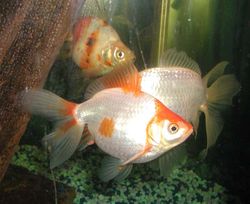
|
|
Scientific classification |
|
|
|
Trinomial name |
Carassius auratus
(Linnaeus,
1758) |
The Goldfish (Carassius auratus) was one of
the earliest
fish to be
domesticated, and is still one of the most commonly kept
aquarium fish. A relatively small member of the
carp family (which also includes the
koi carp and the crucian carp), the goldfish is a
domesticated version of a dark-gray/olive/brown carp native
to east Asia (first domesticated in China)[1] that was
introduced to Europe in the late 17th century. The mutation
that gave rise to the goldfish is also known from other
cyprinid species, such as common carp and tench.
Goldfish may grow to a maximum length of 23 inches
(59 cm) and a maximum weight of 9.9 pounds (4.5 kg),
although this is rare; most individual goldfish grow to
under half this size. In optimal conditions, goldfish may
live more than 20 years (the
world record is 49 years); however, most household
goldfish generally only live six to eight years.[2]
History
During the
Tang Dynasty, it was popular to raise carp in ponds. As the
result of a dominant genetic mutation, one of these carp displayed "gold" (actually
yellowish orange) rather than silver coloration. People
began to breed the gold variety instead of the silver
variety, and began to display them in small containers. The
fish were not kept in the containers permanently, but would
be kept in a larger body of water, such as a pond, and only
for special occasions at which guests were expected would
they be moved to the smaller container.[1]
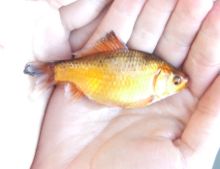
A
crucian carp carrying a mutation for yellow
pigment. Some of the first goldfish may have
looked like this.
In 1162, the empress of the Song Dynasty ordered the building of a pond to collect
the red and gold variety of those carp. By this time, people
outside the royal family were forbidden to keep goldfish of
the gold (yellow) variety, yellow being the royal color.
This probably is the reason why there are more orange
goldfish than yellow goldfish, even though the latter are
genetically easier to breed.
[3]
As time passed, more mutations occurred, producing new
color variations, and fancier varieties of goldfish were
developed. The occurrence of other colors was first recorded
in 1276. The first occurrence of fancy tailed goldfish was
recorded in the Ming dynasty. In 1502, goldfish were
introduced to Japan, where the Ryukin and Tosakin varieties were developed.
In 1611, goldfish were introduced to Portugal and from
there to other parts of Europe. Goldfish were first
introduced to North America in 1874 and quickly became
popular in the United States.
Varieties of domesticated goldfish
Selective breeding over centuries has produced several color
variations, some of them far removed from the "golden" color
of the originally domesticated fish. There are also
different body shapes, fin and eye configurations. Some extreme versions of the
goldfish do need to be kept in an
aquarium — they are much less hardy than varieties
closer to the "wild" original. However, some variations are
hardier, such as the Shubunkin. The main varieties are:
Common
Black Moor
Bubble Eye
Celestial Eye
Comet
Fantail
Calico Fantail
|
Lionhead
Oranda
Pearlscale
Pompom
Ryukin
|
Shubunkin
Telescope Eye
Ranchu
Panda Moor
Veiltail
|
Chinese Goldfish classification
In Chinese goldfish keeping, goldfish are classified into
4 main types, which are not commonly used in the west.
- Dragon Eye - Goldfish with extended eyes, e.g. Black
Moor, Bubble Eye, and Telescope Eye
- Egg - Goldfish without a dorsal fin. e.g.
Lionhead (note that a Bubble Eye without a dorsal
fin belongs to this group)
- Wen - Goldfish with dorsal fin and a fancy tail.
e.g.
Veiltail ("Wen" is also the name of the
characteristic headgrowth on such strains as Oranda and
Lionhead)
- Ce (may also be called "grass") - Goldfish without
anything fancy. This is the type that is usually used in
Japanese carnivals, especially for "goldfish scoops".
- Jikin and Wakin - Goldfish with double tails, but
with the body shapes of comets.
Goldfish in ponds
Goldfish are popular pond fish, since they are small,
inexpensive, colourful, and very hardy. In a pond, they may
even survive if brief periods of ice
form on the surface, as long as there is enough
oxygen remaining in the water and the pond does not
freeze solid.
Common goldfish, London and Bristol shubunkins, Jikin,
Wakin, comet and sometimes fantail can be kept in a pond all
year round in temperate and subtropical climates. Moor,
veiltail, oranda and lionhead are only safe in the summer.
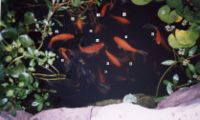
Goldfish pond
Small to large ponds are fine though the depth should be
at least 80 cm (30 in) to avoid freezing. During winter,
goldfish will become sluggish, stop eating, and often stay
on the bottom of the tank. This is completely normal; they
will become active again in the spring. A filter is
important to clear waste and keep the pond clean. Plants are
essential as they act as part of the filtration system, as
well as a food source for the fish. Plants are furthermore
beneficial since they raise oxygen levels in the water.
Compatible fish include rudd, tench, orfe and koi, but
the latter will require specialized care. Ramshorn snails are helpful by eating any algae that
grows in the pond. It is of great importance to introduce
fish that will consume excess goldfish eggs in the pond,
such as orfe. Without some form of population control,
goldfish ponds can easily become overstocked. Koi may also
interbreed to produce a sterile new fish.
Goldfish in aquaria
The goldfish is usually classified as a
coldwater fish, and it can live in an unheated aquarium.
Like most carp, goldfish produce a large amount of waste
both in their feces and through their gills, releasing
harmful chemicals into the water. This also happens because
goldfish cannot digest an excess of proteins, unlike most
tropical fish[citation needed]. Build-up of this waste to
toxic levels can occur in a relatively short period of time,
which is often the cause of a fish's sudden death. It may be
the amount of water surface area, not the water volume, that
decides how many goldfish may live in a container, because
this determines how much oxygen diffuses and dissolves from
the air into the water; one square foot of water surface
area for every inch of goldfish length (370 cm˛/cm). If the
water is being further aerated by way of water pump, filter
or fountain, more goldfish may be kept in the container.
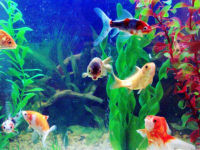
Goldfish aquarium
Goldfish may be coldwater fish, but this does not mean
they can tolerate rapid changes in temperature. The sudden
shift in temperature that comes at night, for example in an
office building where a goldfish might be kept in a small
office tank, could kill them, especially in winter.
Conversely, temperatures over 25 °C (77 °F) can be extremely
damaging for goldfish (this is the main reason why they
shouldn't be kept in tropical tanks).
The popular image of a goldfish in a small
fishbowl is an enduring one. Unfortunately, the risk of
stunting, deoxygenation, ammonia/nitrite poisoning caused by
such a small environment means that this is hardly a
suitable home for any species of fish, and some countries
have banned the sale of bowls of that type under animal
rights legislation.
The supposed reputation of goldfish dying quickly is
often due to poor care amongst uninformed buyers looking for
a "cheap" pet.
The true lifespan of a well-cared-for goldfish in captivity
can extend beyond 10 years.
Fancy goldfish are unlikely to survive for long in the
wild as they are handicapped by their bright fin colors;
however it is not beyond the bounds of possibility that such
a fish, especially the more hardy varieties such as the
Shubunkin, can survive long enough to breed with its wild
cousins. Common and comet goldfish can survive, and even
thrive, in any climate in which a pond for them can be
created. Introduction of wild goldfish can cause problems
for native species. Within three breeding generations the
vast majority of the goldfish spawn will have reverted to
their natural olive color. Since they are carp, goldfish are
also capable of breeding with certain other species of carp
and creating hybrid species.
Research by Dr. Yoshiichi Matsui, a professor of fish
culture at Kinki University in Japan, suggests that there
are subtle differences which demonstrate that while the
crucian carp is the ancestor of the goldfish, they have
sufficiently diverge to be considered separate species.[4]
Feeding
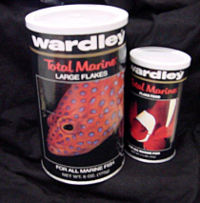
Common flake fish food
Like most fish, goldfish are opportunistic feeders. When
an excess of food is offered, they will produce more waste
and feces, partly due to incomplete digestion of protein.
Overfed fish can sometimes be recognized by feces trailing
from their cloaca. Goldfish need only be fed as much food as
they can consume in three to four minutes, and no more than
twice a day. Extreme overfeeding can be fatal, typically by
bursting of the intestines. This happens most often with selectively
bred goldfish, which have a convoluted intestinal tract as
opposed to a straight one in common goldfish. Novice fishkeepers who have newly purchased ruykin, fantail, oranda,
lionhead or other "fancy" goldfish will need to watch their
fish carefully for a few days, as it is important to know
how much the goldfish will eat in a few minutes of time.
Special goldfish food has a lower protein and higher
carbohydrate content. It is sold in two consistencies -
flakes that float at the top of the
aquarium, and pellets that sink slowly to the bottom.
Goldfish enthusiasts will supplement this diet with
shelled
peas (with outer skins removed), blanched green leafy
vegetables, and bloodworms. Young goldfish also benefit from
the addition of brine shrimp to their diet.
Behavior
Behavior can vary widely both because goldfish are housed
in a variety of environments, and because their behavior can
be conditioned by their owners. A common misconception that
goldfish only have a three second
memory has been proven completely false.[5]
Scientific studies done on the matter have shown that
goldfish have strong associative learning abilities, as well
as social learning skills. In addition, their strong
visual acuity allows them to distinguish between
different humans. It is quite possible that owners will
notice the fish react favorably to them (swimming to the
front of the glass, swimming rapidly around the tank, and
going to the surface mouthing for food) while hiding when
other people approach the
tank. Over time, goldfish should learn to associate
their owners and other humans with food, often "begging" for
food whenever their owners approach.
Goldfish also display a range of
social behaviors. When new fish are introduced to the tank,
aggressive social behaviors may sometimes be seen, such as
chasing the new fish, or fin nipping. These usually stop
within a few days. Fish that have been living together are
often seen displaying schooling behavior, as well as displaying the same types
of feeding behaviors. Goldfish may display similar behaviors
when responding to their reflections in a mirror.
Goldfish that have constant visual contact with humans
also seem to stop associating them as a threat. After being
kept in a tank for several weeks, it becomes possible to
"pet" a goldfish on the head, feed it by hand, or even cup a
hand around it without it reacting in a frightened manner.
Some goldfish have been trained to swim through
mazes, push a ball through a hoop, or even swim in a
synchronized routine by their owners.[6]
Goldfish have behaviors, both as groups and as
individuals that stem from native carp behavior. They are a
generalist species with varied feeding, breeding, and
predators avoidance behaviours that contribute to their
success in the environment. As fish they can be described as
"friendly" towards each other, very rarely will a goldfish
harm another goldfish, nor do the males harm the females
during breeding. The only real threat that goldfish present
to each other is in food competition. Commons, comets, and
other faster varieties can easily eat all the food during a
feeding before fancy varieties can reach it. This can be a
problem that leads to stunted growth or possible starvation
of fancier varieties when they are kept in a
pond with their single-tailed brethren. As a result, when
mixing breeds in an aquarium environment, care should be
taken to combine only breeds with similar body type and swim
characteristics.
Native environment
Goldfish natively live in ponds, and other slow or still
moving bodies of water in depths up to 20 m (65 ft). Their
native climate is subtropical to tropical and they live in
freshwater with a pH of 6.0–8.0, a water hardness of
5.0–19.0 dGH, and a temperature range of 40 to 106 °F (4 to 41 °C)
although they will not survive long at the higher
temperatures. They are considered ill-suited even to live in
a heated tropical fish tank, as they are used to the greater
amount of oxygen in unheated tanks, and some believe that
the heat burns them. However, goldfish have been observed
living for centuries in outdoor ponds in which the
temperature often spikes above 86 °F (30 °C). When found in
nature, the goldfish are actually an olive green color.
In the wild, the diet consists of
crustaceans, insects, and various plant matter.
While it is true that goldfish can survive in a fairly
wide temperature range, the optimal range for indoor fish is
68 to 75 °F (20 to 23 °C). Pet goldfish, as with many other
fish, will usually eat more food than it needs if given,
which can lead to fatal intestinal blockage. They are
omnivorous and do best with a wide variety of fresh
vegetables and fruit to supplement a flake or pellet diet
staple.
Sudden changes in water temperature can be fatal to any
fish, including the goldfish. When transferring a
store-bought goldfish to a pond or a tank, the temperature
in the storage container should be equalized by leaving it
in the destination container for at least 20 minutes before
releasing the goldfish. In addition, some temperature
changes might simply be too great for even the hardy
goldfish to adjust to. For example, buying a goldfish in a
store, where the water might be 70 °F (approximately 21 °C),
and hoping to release it into your garden pond at 40 °F (4
°C) will probably result in the death of the goldfish, even
if you use the slow immersion method just described. A
goldfish will need a lot more time, perhaps days or weeks,
to adjust to such a different temperature.
Because goldfish like to eat live plants, their presence
in an aquarium can be quite a problem. Only a few of the
aquarium plant species can survive in a tank with goldfish,
for example Cryptocoryne and Anubias species, but they require special attention
so that they are not uprooted. Fake plants are often more
durable, but the plant branches can often irritate or harm a
fish if it comes in contact with them.
Breeding
Goldfish, like all
cyprinids, lay eggs. They produce adhesive eggs that
attach to aquatic vegetation. The eggs hatch within 48 to 72
hours, releasing fry large enough to be described as
appearing like "an eyelash with two eyeballs". Within a week
or so, the fry begin to look more like a goldfish in shape,
although it can take as much as a year before they develop a
mature goldfish color; until then they are a metallic brown
like their wild ancestors. In their first weeks of
existence, the fry grow remarkably fast - an adaptation born
of the high risk of getting devoured by the adult goldfish
(or other fish and insects) in their environment.
Goldfish can only grow to sexual maturity if given enough
water and the right nutrition. However if kept well, they
may breed indoors. Breeding usually happens after a
significant change in temperature, often in
spring. Eggs should then be separated into another tank,
as the parents will likely eat any of their young that they
happen upon. Dense plants such as Cabomba or
Elodea or a spawning mop are used to catch the eggs.
Most goldfish can and will breed if left to themselves,
particularly in pond settings. Males chase the females
around, bumping and nudging them in order to prompt the
females to release her eggs, which the males then fertilize.
Due to the strange shapes of some extreme modern bred
goldfish, certain types can no longer breed among
themselves. In these cases, a method of artificial breeding
is used called "hand stripping". This method keeps the breed
going, but can be dangerous and harmful to the fish if not
done correctly.
Mosquito control
Like some other popular aquarium fish, such as the
guppy, goldfish and other carp are frequently added to
stagnant bodies of water in order to reduce the mosquito
populations in some parts of the world, especially to
prevent the spread of West Nile Virus, which relies on
mosquitoes to migrate. However, the introduction of goldfish
has often had negative consequences for local ecosystems.[7]
Edibility and cruelty
Although edible, goldfish are rarely eaten. A fad among
North American college students for many years was
swallowing goldfish as a stunt and as an initiation process
for fraternities. The first recorded instance was in 1939 at
Harvard University.[8]
The practice gradually fell out of popularity over the
course of several decades and is no longer continued.
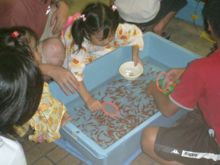
Goldfish being scooped up
In many countries, the operators of
carnivals and fairs commonly give goldfish away in plastic
bags as prizes for winning games. In the United Kingdom, the
government proposed banning this practice as part of its
Animal Welfare Bill,[9][10] though this has since been
amended to only prevent goldfish being given as prizes to
unaccompanied minors.[11] However, in Rome, Italy, the city
passed a law in late 2005, which banned the use of goldfish
or other animals as carnival prizes. Rome has also banned the keeping of goldfish in
"goldfish bowls", on the premise that it's cruel to the fish
to live in such a small, confined space.[12]
Killing fish humanely for human consumption or benign
purposes (such as putting down an ill fish) is still legal
in most countries (provided that the fish is not a protected
fish caught in the wild, a fish in protected reserves or in
water where the person concerned has no right to collect the
fish). In the United Kingdom, it is illegal to sell live
fish (including goldfish) as "feeder fish" for consumption
by other animals.
See also
Notes
References
External links
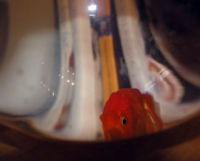
A distorted view of a goldfish in a goldfish
bowl.
Varieties
-
Goldfish Pages - Hobbyists web site that provides
information on goldfish standards, goldfish varieties
and goldfish care.
- Goldfish varieties:
Page 1
Page 2
-
Bristol Aquarists' Society - Photographs and
descriptions of the different goldfish varieties
-
Goldfish Genetics - A resource on the genetics of
the goldfish with a focus on the originator, crucian
carp, and how their basic genetic package gave rise to
the varieties of modern goldfish.
Care
Other




